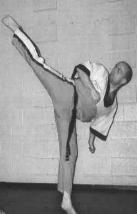Flexibility Training

"Do your high kicks embarrass you?" - Here's the answer
This section on flexibility training will give you a very firm grasp of the basic principles of flexibilty training. The pages listed at the bottom of this page contain a wealth of information related to flexibility training and stretching.
Version: 1.18, Last Modified 94/10/12 Copyright (C) 1993, 1994 by Bradford D. AppletonPermission is granted to make and distribute verbatim copies of this document provided the copyright notice and this permission notice are preserved on all copies.
This document is a modest attempt to compile a wealth of information in order to answer some frequently asked questions about stretching and flexibility training. It is organized into chapters covering the following topics:
Physiology of Stretching / flexibility training
Types of Stretching
How to Stretch
Although each chapter may refer to sections in other chapters, it is not required that you read every chapter in the order presented. It is important, however, that you read the disclaimer before reading any other sections of this document.
Disclaimer.The author makes no warranty of any kind in regard to the content of this document, including, but not limited to, any implied warranties of merchantability, or fitness for any particular purpose. The author of this document shall not be liable for errors contained in it, or for incidental or consequential damages in connection with the furnishing of, use of, or reliance upon information contained in this document. In other words: "I'm not a doctor, nor do I play one on TV!" I can not be held liable for any damages or injuries that you might suffer from somehow relying upon information in this document, no matter how awful. Not even if the information in question is incorrect or inaccurate.
Thanks to all the readers of the `rec.martial-arts', `rec.arts.dance' and `misc.fitness' newsgroups on Usenet who responded to my request for questions (and answers) on stretching. Many parts of this document come directly from these respondents. Thanks in particular to Shawne Neeper for sharing her formidable knowledge of muscle anatomy and physiology.
Other portions of this document have been taken from the following books:
Sport Stretch, by Michael J. Alter (referred to as M. Alter in the rest of this document)
Stretching Scientifically, by Tom Kurz (referred to as Kurz in the rest of this document)
SynerStretch For Total Body Flexibility, from Health For Life (referred to as SynerStretch in the rest of this document)
The Health For Life Training Advisor, also from Health For Life (referred to as HFLTA in the rest of this document)
Mobility Training for the Martial Arts, by Tony Gummerson (referred to as Gummerson in the rest of this document)
Further information from these books and others are available on flexibility training
Physiology of stretching
Flexibility understood
Types of stretching
How to stretch
Work towards the splits & Joint motion - normal ranges



